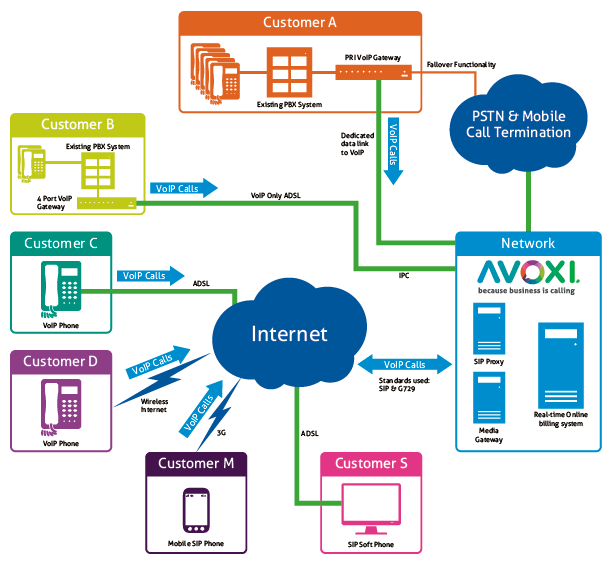The purpose of this document is to provide potential clients with basic technical information about AVOXI. It includes a high-level description of services, technologies, hardware and software that may be applicable to the AVOXI offer. Some examples are also presented to provide a real-world perspective of VoIP integration.
AVOXI Services
AVOXI offers a world-class Voice over IP (VoIP) service at cost-effective rates. The primary drive behind the VoIP service is to provide clients with substantial savings on their Voice Communication Costs. We consider the quality of your calls to be non-negotiable. We aim to provide our clients with the best possible service at all times.
AVOXI implements proven carrier-grade equipment and billing systems to ensure the highest quality of service. The use of multiple redundant links and interconnects ensures we always have connectivity and your call will reach its destination. Our billing systems are real-time and online, enabling clients to view an up to date bill at a click of a button.
In addition, AVOXI offers bundled data connections and consultation services for data connectivity that may be required for the effective use of the VoIP service.
Please see the AVOXI product descriptions for more detailed information and Value Added Services.
What is VoIP and how does it work?
VoIP is a technology that allows you to make telephone calls over any IP based network. Instead of using a traditional phone line, you can use the Internet to make calls. By making calls over the Internet, you can lower your monthly phone bill considerably, experience greater call quality and even take your unique telephone number with you anywhere in the world!
VoIP is available in various different formats and standards. The two most important technologies related to VoIP are the Signaling Protocol and the Media Codec. The signaling protocol is used to establish, modify and terminate calls. The media codec is an algorithm that encodes (and decodes) your voice into digital data packets that can be sent across the internet.
AVOXI makes use of the Session Initiation Protocol (SIP) for cell signaling. The SIP protocol is a standard defined by the Internet Engineering Task Force (IETF) in RFC3261. In short, this means any device or software that is SIP compliant should interface correctly with the AVOXI service. SIP is a widely available and often implemented protocol.
AVOXI exclusively uses the G.729 codec. The codec’s compression provides excellent voice quality with minimal bandwidth usage. The codec is defined by the International Telecommunication Union and is a royalty-bearing codec. In other words, royalties are payable for every G.729 call. VoIP hardware and software vendors pay royalties to support G.729 in their products.
Examples: VoIP integration
To illustrate VoIP integration, we will explain a few simple examples below. The examples listed below are by no means an exhaustive list of scenarios, there may be several solutions to the same problem and even more scenarios.
Example A
Customer A is a medium to large business with 50 or more employees and telephone extensions. A large PABX system is already in place. The customer considers the telephone system as mission-critical. These customers often have several branches that can all be linked to the AVOXI service and phone one another for free.

In this case, the existing telephony equipment is kept in place. Only a PRI VoIP gateway is installed to capture the calls and terminate them via AVOXI. The customer should not experience any change in the operation of the current telephone system. The gateway is configured in such a way to failover to the PSTN if the VoIP service is not available. A single PRI gateway allows for up to 30 simultaneous calls. The maximum bandwidth usage is 26Kbit/s * 30 = 780 kbit/s. Dedicated VoIP bandwidth is directly connected to AVOXI by means of a leased line or metro Ethernet connection.
Example customer B
Customer B is a small to medium type of business. The business has a minimum of 4 analog or BRI telephone lines. A small PABX system is already in place. In this case, an analog or BRI VoIP gateway is installed and the current system is kept intact. No change in the operation of the current telephone system is experienced. The gateway is configured in such a way to failover to the PSTN if the VoIP service is not available.
If we assume the customer has 4 BRI lines, a 4 BRI Port - 8 VoIP channel gateway is installed. The maximum bandwidth usage is 26Kbit/s * 8 = 208Kbit/s. This is dangerously close to the maximum upload speed of 250 Kbit/s for South African ADSL. AVOXI does not recommend above 50% utilization on any ADSL line as this usually results in bad voice quality. It is recommended to use a dedicated 4Mbit/s ADSL line for this customer. Depending on location most 4Mbit/s ADSL lines have an upload speed of 512Kbit/s. No more than 4 concurrent calls is recommended on a 512Kbit/s ADSL line. It is recommended you use an AVOXI ADSL account as it will ensure the best possible VoIP quality.
Example customer C & D
Customer C and D are a home/home office user. Only one or two telephone lines are required by this customer. Customer C has an ADSL line and Customer D makes use of a wireless type of internet connection. The applicable bandwidth should be closely inspected to ensure it is suitable for VoIP. Although only a small amount of bandwidth is required for a single VoIP Call it is imperative to do the bandwidth planning correctly. These types of users commonly use the same connection for browsing the internet or emails. In this case, the Router’s QoS parameters should be correctly configured.
In this case, a simple hardware IP phone or ATA can be installed to provide the VoIP functionality.
Example customer M
It is possible to load SIP client software on certain types of mobile phones. The software provides the necessary VoIP functionality to make cheaper calls directly from your mobile device. The mobile device must be 3G enabled to be able to make a VoIP call. The difficulty of this setup is that it is dependent on your service provider’s 3G network coverage. In other words, in some areas the VoIP call will work perfectly, in others they may not work at all. Even if there is good 3G coverage in the area it does not guarantee a reliable VoIP call. It may be that there are too many users in the area using the same 3G bandwidth. These factors are out of our control and make it nearly impossible to guarantee voice quality.
Example customer S
Customer S simply loads the appropriate software on his PC and can start making calls using the PC’s audio system or headset. This software is commonly referred to as a SoftPhone. Commonly call centers or receptionists make use of this configuration.
Bandwidth and quality of service parameters should be closely monitored and managed in order to ensure reliable call quality.
AVOXI recommends the use of Eyebeam, a softphone from Counterpath. It can be purchased online from www.counterpath.com.
Appendix 1 – Bandwidth Calculations
Bandwidth planning is incredibly important when providing a VoIP service. Insufficient data bandwidth can cause bad call quality to the service as a whole.
A useful tool to calculate the required bandwidth can be found at http://www.bandcalc.com/. As mentioned above AVOXI makes use of the following configurations:
- Codec: G.729
- Payload size: Min 40ms, Max 60ms.
Using the above calculator, you will get the following results. Bandwidth usage Per call:
- Payload Size of 30ms: 30.8 Kbit/s
- Payload Size of 40ms: 25.2 Kbit/s
- Payload Size of 60ms: 19.6 Kbit/s
Always use the 40ms payload when doing bandwidth calculations to build in an additional margin on the bandwidth. In most cases, you should configure the VoIP equipment for a payload size of 60ms to save even more on bandwidth. An additional 5% bandwidth should be added to compensate for SIP signaling.
VoIP is asymmetric service. It uses an equal amount of bandwidth in the upload and downloads direction. This should be remembered when doing bandwidth planning on asymmetric links.
Example Telkom ADSL and maximum simultaneous/concurrent calls
Telkom offers an Asymmetric Digital Subscriber Line (ADSL) service. The service is Asymmetric because it has different upload and download speeds. Always use the lowest of the speeds to determine the maximum allowable calls on the same link. In addition to this AVOXI does not recommend more than 50%-60% of ADSL links to improve the VoIP quality.
What do i need (hardware, software, bandwidth) to start using VoIP?
bandwidth
First and foremost, you need a reliable and fast data connection. Depending on your needs there are several different options available to enable the use of the AVOXI VoIP service. The easiest and often the cheapest solution is a good broadband internet connection. In most cases, a fixed broadband connection serves as the most reliable medium to run the VoIP service on.
VoIP is sensitive to network conditions like latency, packet loss, and excessive jitter. These conditions are commonly associated with wireless connections and or heavily congested connections. Without proper bandwidth planning and Quality of Service parameters, these network conditions cause voice quality degradation.
A typical G.729 call with a payload of 40ms uses 26 Kbit/s of full-duplex bandwidth.
The number of concurrent calls can be computed by using the above statistic. For example, a 128 Kbit/s full-duplex link will safely be able to handle 128 / 26 = 4.9 => 4 simultaneous calls. Please also note that technologies like ADSL have different uplink and downlink speeds. Typical values are 1Mbit/s downlink & 250 Kbit/s uplink. Always use the smaller of the two values to compute the maximum concurrent calls. AVOXI uses a payload of between 40 and 60ms. This means in most cases even less bandwidth will be used per call.
VoIP user agents: hardware or software
Today there are several options available that make it easy to start using VoIP. You will need some type of “User-Agent” that understands the above-mentioned protocols. The user agent may be software on your PC, an invisible VoIP gateway behind your company’s PABX or an IP-Phone that looks and operates like a traditional telephone.
Strictly speaking any SIP and G.729 compliant device should interface successfully with the AVOXI service. In general, this is the case and AVOXI will not restrict you from using your preferred device. However, AVOXI will only sell and support products that have proven reliable in South African conditions. Some examples of VoIP devices are:
- SoftPhone: A Softphone is a software that is installed on your PC or Mobile device. A headset with a microphone may be used to record and playback the call’s audio. AVOXI recommends the use of Eyebeam. It can be purchased online at www.counterpath.com.
- IP Phone: An IP-Phone looks and operates like a traditional telephone. The only difference is it connects directly to your data network via Ethernet. Typically, the telephone can be configured via a web interface. AVOXI offers a range of IP-Phones with different features and prices.
- § VoIP Gateway: A gateway is typically used to enable existing telephony equipment to make use of a VoIP service. The simplest example would be to install a VoIP gateway behind your old analog telephone and start making VoIP calls. In addition, failover functionality is available by sending the calls via the PSTN if the VoIP connection is unavailable. AVOXI primarily makes use of the Quantum range of gateways.

